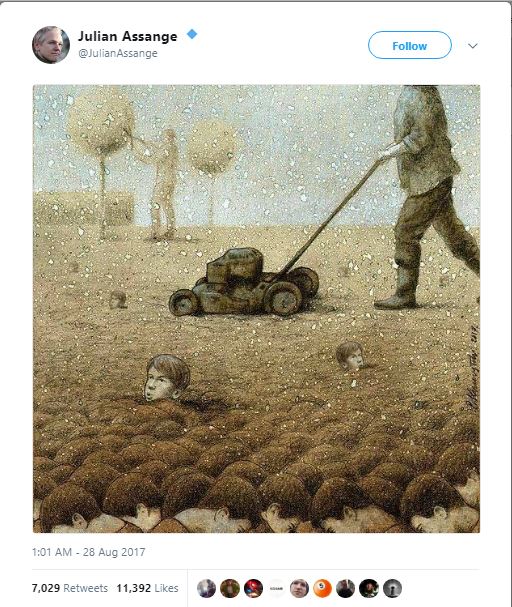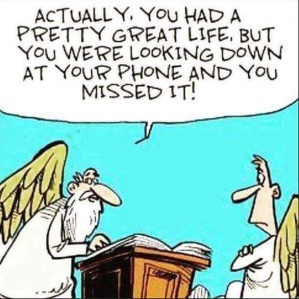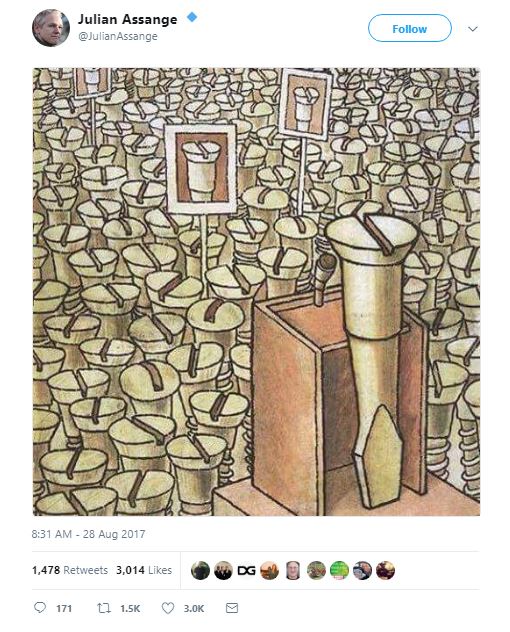At 1:01 AM on the 28th of August, Julian Assange tweeted an image from the Embassy of Ecuador in London. It depicted a huddled mass of people staring at their phones, with just a few brave figures daring to look away from their screens, and then, being cruelly cut down by an anonymous authority figure. It makes a clear and direct reference to Assange’s own work with testing the limits of privacy and government control of information with whistle-blower site Wikileaks, and is a great example of a type of image I’m sure you’ve scrolled across before.
It is my contention that this is more than a lame or dull image, but part of a much larger and very vibrant genre of art – let’s call it Wake Up Sheeple art. Mostly these are illustrations or memes and broadly the message communicated is that others are dumb, perhaps society at large is hopelessly stupid, hypocritical or both, and just a few disaffected individuals can see through it all. I have yet to see any of this stuff that is any good, but why it is so compelling to so many is itself fascinating. We need to talk about it.

The artwork Assange posted is “Perfect Garden” by artist Paweł Kuczyński (a lot of commenters were annoyed to see an artwork uncredited). Kuczyński is an interesting example of this genre. Works of his have used the same optical illusion of masses below and symbol above but this time for Facebook, some have a similarly lame message, others have explicitly anti-imperialist and Marxist messages, occasionally they play with the aesthetic of a 15 year old who has just discovered Punk music, and this one seems fairly racist.
Not everything Kuczyński produces is strictly Wake Up Sheeple art, and neither is he the definitive artist of this genre. Looking across the extensive archive of this stuff on two Reddit groups ( /r/im14andthisisdeep and /r/phonesarebad), the complexity of this genre begins to reveal itself. There are a few defining themes which obsessively return.
Young people these days are missing out on the real experiences I had in my youth, they’re selfish and lazy, hopelessly incapable of appreciating the finer things in life, the true beauty of books and sunsets, and any authentic human connection.
People more generally suck too. They are, again, hopelessly stuck to their screens. They don’t care about others. And everything they do care about is a hopelessly shallow game for attention on social media. It is always others.
If phones are the stand-in for everything that is wrong with today, books are the Utopian vision for perfect times past and a future worth saving. Invariably these images are desperately smug. The new revolutionary front is chastising others entertainment preferences, scorning new media. Where do you work out? The library.

Most of what I’m discussing today has been digital illustrations and memes, flowing across one online community to another. Examples of this in real life are plentiful too, existing as street art, found in newspapers, and even, as birthday cards.
One thing that unifies Wake Up Sheeple art whether it is found online or offline, is it’s view of history. Society is on a steady decline, towards stupidity and tyranny. The depiction of evolution with present day humanity bent over, cradling their iPhone, is such a common trope I almost don’t mind at this stage – it’s become a rite of passage of sorts, which is oddly nice. Elsewhere, the phone is a prison and society is a factory. We’re alienated beings, trapped by our tools and the corporations that make them. This is actually Wake Up Sheeple art at its best, the real shame is the best alternative it can imagine is enjoying nature a bit more.
… lol what if instead of evolution, the iPhone was a devolution [thunderous applause: the sound of millions of likes, retweets and reposts].
… we’re alienated by larger forces is actually good politics, but it can’t imagine a better future. Here is the best Žižek quote, which is loosely related:
Think about the strangeness of today’s situation. Thirty, forty years ago, we were still debating about what the future will be: communist, fascist, capitalist, whatever. Today, nobody even debates these issues. We all silently accept global capitalism is here to stay. On the other hand, we are obsessed with cosmic catastrophes: the whole life on earth disintegrating, because of some virus, because of an asteroid hitting the earth, and so on. So the paradox is, that it’s much easier to imagine the end of all life on earth than a much more modest radical change in capitalism.
The worst people in the eyes of Wake Up Sheeple art are fat people eating and attractive women taking selfies: it’s notable that so often the representation of humanity at large are twenty-something males, not athletic and not overweight. People take too many selfies and eat too much not because they are greedy, but because they lack any motivation for something more dignified – unlike the male hero. Obesity is a common target here sure, but it is portrayed as a symptom pouring out from endless politicians speeches, hypocrisy at large, and from too many apps on your smartphone. Distraction and laziness are the real sins, with a familiar culprit responsible: Garden of Eden 2.0.
Wake Up Sheeple is a genre of art that is often criticised for the simplistic style and message, being accused of laziness, stupidity and immaturity. In many ways this is missing the point, the community behind it claim to have their minds blown by these so deep messages not because of the sophistication of the craft or delivery. There is a coherent circulation between style and content, a loop of getting it. To create this content or just to share it is fundamentally the same – here, the viewer is accused as guilty, damning the entirety of society itself. The appeal to a democratic ideal, motivated in part by a healthy dose of anti-authoritarianism, is why it is shrugged off as naïve, lumped in with all the other trappings of youth culture. The authorities are always vague, and an amorphous “we the people” ever present. As art it is bad, simply because it builds an expectation it is hopelessly inadequate to deliver, it is far too didactic to blow your mind: inevitably it fails. But just like any good polemic, the stakes are raised – there is no neutrality.
If there was any hope for Wake Up Sheeple art to genuinely raise consciousness about the political structures that have created historic levels of inequality, and is normalising a growing culture of precarity, poverty and exploitation, than we could forgive its flaws. Wake Up Sheeple art is not about expanding the boundaries of political discourse, but rather, a condemnation of those around you. It may be motivated by a legitimate frustration with the apathy of others, or just an undeserved sense of intelligence. It relies on trite depictions of vague authority figures, and often communicates an oddly reactionary politics. As a genre, it is hopeless doomed to wallow in its own self-conceited echo chamber.
Assange just won’t stop tweeting the stuff. He posted this just 7 hours after the first one.

- Chris Hayes is an Irish artist and art critic in London, with a background in technology and alternative spaces. Follow on Facebook and Twitter.




















